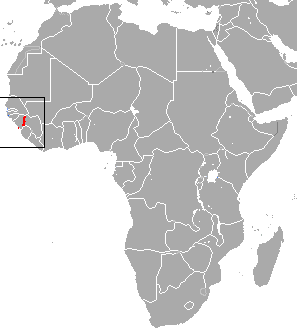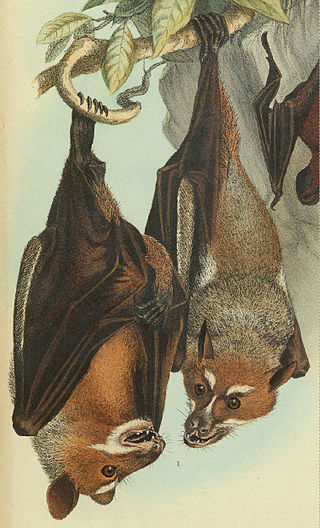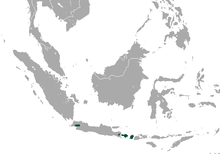
Bushmeat is meat from wildlife species that are hunted for human consumption. Bushmeat represents a primary source of animal protein and a cash-earning commodity in poor and rural communities of humid tropical forest regions of the world.

Pteropus is a genus of megabats which are among the largest bats in the world. They are commonly known as fruit bats or flying foxes, among other colloquial names. They live in South Asia, Southeast Asia, Australia, East Africa, and some oceanic islands in the Indian and Pacific Oceans. There are at least 60 extant species in the genus.

The tailless fruit bat is a species of fruit bat in the family Pteropodidae.

The black flying fox or black fruit bat is a bat in the family Pteropodidae. It is among the largest bats in the world, but is considerably smaller than the largest species in its genus, Pteropus. The black flying fox is native to Australia, Papua New Guinea, and Indonesia. It is not a threatened species.
The Sulawesi yellow bat is a species of vesper bat. It is found only in Indonesia.

The Sulawesi flying fox or Sulawesi fruit bat is a species of megabat endemic to Indonesia. It is classified as "Vulnerable" by the IUCN due to unsustainable levels of hunting.

The wrinkle-lipped free-tailed bat is a species of bat in the family Molossidae. It is found in Bangladesh, Bhutan, Cambodia, China, Cocos (Keeling) Islands, India, Indonesia, Laos, Malaysia, Myanmar, Nepal, the Philippines, Sri Lanka, Thailand and Vietnam.

The Madagascan fruit bat is a species of bat in the family Pteropodidae. It is endemic to Madagascar and is listed as "Vulnerable" by the IUCN because it is hunted as bushmeat.

The straw-coloured fruit bat is a large fruit bat that is the most widely distributed of all the African megabats. It is quite common throughout its area ranging from the southwestern Arabian Peninsula, across forest and savanna zones of sub-Saharan Africa. It is listed as Near Threatened on the IUCN Red List due to a decreasing population trend. Straw-coloured fruit bats travel in massive colonies of at least 100,000 bats and sometimes massing up to 1 million. From October to end of December every year, in the largest migration of mammals on the planet, up to 10 million straw-coloured fruit bats congregate in Kasanka National Park, Zambia, roosting in a 2 hectare area of Mushitu forest each day. This migration was only discovered in 1980. Their necks and backs are a yellowish-brown colour, while their undersides are tawny olive or brownish.

The harpy fruit bat is a species of megabat in the family Pteropodidae. It is endemic to the Philippines.

Lyle's flying fox is a species of flying fox in the family Pteropodidae. It is found in Cambodia, Thailand and Vietnam, with an outlying population in Yunnan, China. It faces persecution from farmers and it is killed for bushmeat in parts of its range. The International Union for Conservation of Nature has rated its conservation status as being "vulnerable".

Maclaud's horseshoe bat is a species of bat in the family Rhinolophidae. It is endemic to Guinea. Its natural habitats are moist savanna, caves and other subterranean habitats. It is one of five African microbat species to be listed as endangered by the IUCN. In 2013, Bat Conservation International listed this species as one of the 35 species of its worldwide priority list of conservation. It is threatened by habitat loss.

The Sulawesi rousette or Sulawesi fruit bat is a species of megabat in the family Pteropodidae endemic to Sulawesi, an island in Indonesia. It is presently the only member of the genus Pilonycteris.

The Wallace's or Sulawesi stripe-faced fruit bat is a species of megabat in the family Pteropodidae. It is endemic to Sulawesi and the nearby Togian Islands of Indonesia. Cave paintings resembling these bats have been found in Australia, where bats of this kind are not otherwise known.

The moss-forest blossom bat is a species of megabat in the family Pteropodidae found in New Guinea. Its natural habitat is subtropical and tropical dry forests.

The Bougainville monkey-faced bat or Bougainville flying monkey is a megabat endemic to Bougainville Island of Papua New Guinea and Choiseul Island of the Solomon Islands in Melanesia. It inhabits mature forests in upland areas, within the Autonomous Region of Bougainville and Bougouriba Province.

The cave nectar bat, dawn bat, common dawn bat, common nectar bat or lesser dawn bat is a species of megabat within the genus Eonycteris. The scientific name of the species was first published by Dobson in 1871.

The greater monkey-faced bat or greater flying monkey is a megabat endemic to Solomon Islands, Bougainville, in Papua New Guinea, and nearby small islands. It is listed as a critically endangered species and the population is decreasing. It is the largest monkey-faced bat.

Bats as food are eaten by people in some areas of North America, Asia, Africa, Pacific Rim countries, and some other cultures, including the United States, China, Vietnam, the Seychelles, the Philippines, Indonesia, Palau, Thailand, and Guam. Half the megabat species are hunted for food but only eight percent of the insectivorous bat species are. In Guam, Mariana fruit bats are considered a delicacy.
The Bornean woolly horseshoe bat or Proconsul's horseshoe bat is an endangered species of horseshoe bat found on Borneo. Though it was discovered in 1959, it was not recognized as a distinct species until 2013.


















